Manipulating Transverse Spin Angular Momentum with Symmetrically Modulated Hybridly Polarized Vector Optical Field
Abstract
1. Introduction
2. Design and Generation of SM-HP-VOF
3. The Manipulation of the Transverse SAM of the Tightly Focused SM-HP-VOF
4. Conclusions
Author Contributions
Funding
Institutional Review Board Statement
Informed Consent Statement
Data Availability Statement
Conflicts of Interest
References
- Zhan, Q. Cylindrical vector beams: From mathematical concepts to applications. Adv. Opt. Photonics 2009, 1, 1–57. [Google Scholar] [CrossRef]
- Chen, J.; Wan, C.; Zhan, Q. Vectorial optical fields: Recent advances and future prospects. Sci. Bull. 2018, 63, 54–74. [Google Scholar] [CrossRef]
- Paterson, L.; MacDonald, M.P.; Arlt, J.; Sibbett, W.; Bryant, P.; Dholakia, K. Controlled rotation of optically trapped microscopic particles. Science 2001, 292, 912–914. [Google Scholar] [CrossRef] [PubMed]
- Wang, X.-L.; Chen, J.; Li, Y.; Ding, J.; Guo, C.; Wang, H.-T. Optical orbital angular momentum from the curl of polarization. Phys. Rev. Lett. 2010, 105, 253602. [Google Scholar] [CrossRef] [PubMed]
- Dorn, R.; Quabis, S.; Leuchs, G. Sharper focus for a radially polarized light beam. Phys. Rev. Lett. 2003, 91, 233901. [Google Scholar] [CrossRef]
- Wang, H.; Shi, L.; Lukyanchuk, B.; Sheppard, C.; Chong, C.T. Creation of a needle of longitudinally polarized light in vacuum using binary optics. Nat. Photonics 2008, 2, 501–505. [Google Scholar] [CrossRef]
- Pan, Y.; Gao, X.Z.; Cai, M.Q.; Zhang, G.L.; Li, Y.; Tu, C.; Wang, H.T. Fractal vector optical fields. Opt. Lett. 2016, 41, 3161–3164. [Google Scholar] [CrossRef]
- Hu, H.; Gan, Q.; Zhan, Q. Generation of a nondiffracting superchiral optical needle for circular dichroism imaging of sparse subdiffraction objects. Phys. Rev. Lett. 2019, 122, 223901. [Google Scholar] [CrossRef]
- Gabriel, C.; Aiello, A.; Zhong, W.; Euser, T.G.; Joly, N.Y.; Banzer, P.; Fortsch, M.; Elser, D.; Andersen, U.L.; Marquardt, C. Entangling different degrees of freedom by quadrature squeezing cylindrically polarized modes. Phys. Rev. Lett. 2011, 106, 060502. [Google Scholar] [CrossRef]
- Fickler, R.; Lapkiewicz, R.; Plick, W.N.; Krenn, M.; Schaeff, C.; Ramelow, S.; Zeilinger, A. Quantum entanglement of high angular momenta. Science 2012, 338, 640–643. [Google Scholar] [CrossRef]
- Daloi, N.; Dey, T.N. Vector beam polarization rotation control using resonant magneto optics. Opt. Express 2022, 30, 21894–21905. [Google Scholar] [CrossRef] [PubMed]
- Liu, M.; Lei, Y.Z.; Yu, L.; Fang, X.; Ma, Y.; Liu, L.; Zheng, J.; Gao, P. Super-resolution optical microscopy using cylindrical vector beams. Nanophotonics 2022, 11, 3395–3420. [Google Scholar] [CrossRef]
- Zhao, N.; Li, X.; Li, G.; Kahn, J.M. Capacity limits of spatially multiplexed free-space communication. Nat. Photonics 2015, 9, 822–826. [Google Scholar] [CrossRef]
- Gao, X.-Z.; Pan, Y.; Wang, D.; Li, Y.; Tu, C.; Wang, H.-T. Vector optical fields broken in the spatial frequency domain. Phys. Rev. A 2016, 93, 033834. [Google Scholar] [CrossRef]
- Devlin, R.C.; Ambrosio, A.; Rubin, N.A.; Mueller, J.P.B.; Capasso, F. Arbitrary spin-to-orbital angular momentum conversion of light. Science 2017, 358, 896–900. [Google Scholar] [CrossRef] [PubMed]
- Wang, X.-L.; Li, Y.; Chen, J.; Guo, C.-S.; Ding, J.; Wang, H.-T. A new type of vector fields with hybrid states of polarization. Opt. Express 2010, 18, 10786–10795. [Google Scholar] [CrossRef]
- Lerman, G.M.; Stern, L.; Levy, U. Generation and tight focusing of hybridly polarized vector beams. Opt. Express 2010, 18, 27650–27657. [Google Scholar] [CrossRef] [PubMed]
- Colas, D.; Dominici, L.; Donati, S.; Pervishko, A.A.; Liew, T.C.H.; Shelykh, I.A.; Ballarini, D.; De Giorgi, M.; Bramati, A.; Gigli, G.; et al. Polarization shaping of Poincaré beams by polariton oscillations. Light-Sci. Appl. 2015, 4, e350. [Google Scholar] [CrossRef]
- Shu, W.; Ling, X.; Fu, X.; Liu, Y.; Ke, Y.; Luo, H. Polarization evolution of vector beams generated by q-plates. Photonics Res. 2017, 5, 64–72. [Google Scholar] [CrossRef]
- Gao, X.-Z.; Wang, M.-S.; Zhao, J.-H.; Zhao, P.-C.; Zhang, X.; Pan, Y.; Li, Y.; Tu, C.; Wang, H.-T. Generation and Tunable Focal Shift of the Hybridly Polarized Vector Optical Fields with Parabolic Symmetry. Chin. Phys. Lett. 2020, 37, 124201. [Google Scholar] [CrossRef]
- Yang, H.W.; Pan, J.; Zhang, S.; Zhu, W.; Zhang, L.; Zheng, H.; Zhong, Y.; Yu, J.; Chen, Z. Steering Nonlinear Twisted Valley Photons of Monolayer WS2 by Vector Beams. Nano Lett. 2021, 21, 7261–7269. [Google Scholar] [CrossRef] [PubMed]
- Zhao, J.-H.; Pan, Y.; Gao, X.-Z.; Ma, R.; Man, Z.-X.; Ren, Z.-C.; Tu, C.; Li, Y.; Wang, H.-T. Five-dimensional Poincaré sphere system for representing azimuthally varying vector optical fields. Phys. Rev. A 2022, 106, 023506. [Google Scholar] [CrossRef]
- Bliokh, K.Y.; Bekshaev, A.Y.; Nori, F. Extraordinary momentum and spin in evanescent waves. Nat. Commun. 2014, 5, 3300. [Google Scholar] [CrossRef] [PubMed]
- Aiello, A.; Banzer, P.; Neugebaueru, M.; Leuchs, G. From transverse angular momentum to photonic wheels. Nat. Photonics 2015, 9, 789–795. [Google Scholar] [CrossRef]
- Zhu, W.; Shvedov, V.; She, W.; Krolikowski, W. Transverse spin angular momentum of tightly focused full Poincaré beams. Opt. Express 2015, 23, 34029–34041. [Google Scholar] [CrossRef]
- Li, M.; Yan, S.; Yao, B.; Liang, Y.; Zhang, P. Spinning and orbiting motion of particles in vortex beams with circular or radial polarizations. Opt. Express 2016, 24, 20604–20612. [Google Scholar] [CrossRef]
- Chen, J.; Wan, C.; Kong, L.; Zhan, Q. Experimental generation of complex optical fields for diffraction limited optical focus with purely transverse spin angular momentum. Opt. Express 2017, 25, 8966–8974. [Google Scholar] [CrossRef]
- Li, M.; Yan, S.; Liang, Y.; Zhang, P.; Yao, B. Transverse spinning of particles in highly focused vector vortex beams. Phys. Rev. A 2017, 95, 053802. [Google Scholar] [CrossRef]
- Chen, J.; Wan, C.; Kong, L.; Zhan, Q. Tightly focused optical field with controllable photonic spin orientation. Opt. Express 2017, 25, 19517–19528. [Google Scholar] [CrossRef]
- Neugebauer, M.; Eismann, J.S.; Bauer, T.; Banzer, P. Magnetic and Electric Transverse Spin Density of Spatially Confined Light. Phys. Rev. X 2018, 8, 021042. [Google Scholar] [CrossRef]
- Han, L.; Liu, S.; Li, P.; Cheng, H.; Zhao, J. Catalyst like effect of orbital angular momentum on the conversion of transverse to three-dimensional spin states within tightly focused radially polarized beams. Phys. Rev. A 2018, 97, 053802. [Google Scholar] [CrossRef]
- Pan, Y.; Gao, X.-Z.; Zhang, G.-L.; Li, Y.; Tu, C.; Wang, H.-T. Spin angular momentum density and transverse energy flow of tightly focused kaleidoscope-structured vector optical fields. APL Photonics 2019, 4, 096102. [Google Scholar] [CrossRef]
- Gao, X.-Z.; Zhao, J.-H.; Wang, M.-S.; Liu, J.-J.; Zhang, G.-B.; Pan, Y. Bipolar-variant spin angular momentum and its evolution in a tight focusing process. Phys. Rev. A 2020, 102, 063514. [Google Scholar] [CrossRef]
- Qin, Y.; Ji, B.; Song, X.; Lin, J. Disclosing transverse spin angular momentum of surface plasmon polaritons through independent spatiotemporal imaging of its in-plane and out-of-plane electric field components. Photonics Res. 2020, 8, 1042–1048. [Google Scholar] [CrossRef]
- Eismann, J.S.; Nicholls, L.H.; Alonso, M.A.; Banzer, P.; Rodriguez-Fortuno, F.J.; Zayats, A.V.; Nori, F.; Bliokh, K.Y. Transverse spinning of unpolarized light. Nat. Photonics 2021, 15, 156–161. [Google Scholar] [CrossRef]
- Gao, X.-Z.; Zhao, J.-H.; Zhao, P.-C.; Sun, X.-F.; Yang, F.; Liu, J.-J.; Pan, Y. Purely transverse spin angular momentum modulated by the singularity phase. J. Opt. 2021, 23, 115603. [Google Scholar] [CrossRef]
- Zhang, X.; Shen, B.; Zhu, Z.; Rui, G.; He, J.; Cui, Y.; Gu, B. Understanding of transverse spin angular momentum in tightly focused linearly polarized vortex beams. Opt. Express 2022, 30, 5121–5130. [Google Scholar] [CrossRef]
- Ma, Y.; Zhao, H.; Liu, N.; Gao, Z.; Mohajerani, S.S.; Xiao, L.; Hone, J.; Feng, L.; Strauf, S. On-chip spin-orbit locking of quantum emitters in 2D materials for chiral emission. Optica 2022, 9, 953–958. [Google Scholar] [CrossRef]
- Meng, X.; Wan, C.; Zhan, Q. Transversely oriented cylindrically polarized optical fields. Opt. Express 2022, 30, 14897–14909. [Google Scholar] [CrossRef]
- Gu, B.; Wen, B.; Rui, G.; Xue, Y.; Zhan, Q.; Cui, Y. Varying polarization and spin angular momentum flux of radially polarized beams by anisotropic Kerr media. Opt. Lett. 2016, 41, 1566–1569. [Google Scholar] [CrossRef]
- Chen, R.-P.; Chew, K.-H.; Dai, C.-Q.; Zhou, G. Optical spin-to-orbital angular momentum conversion in the near field of a highly nonparaxial optical field with hybrid states of polarization. Phys. Rev. A 2017, 96, 053862. [Google Scholar] [CrossRef]
- Chen, R.-P.; Gao, T.-Y.; Chew, K.-H.; Dai, C.-Q.; Zhou, G.-Q.; He, S.-L. Near-field characteristics of highly non-paraxial subwavelength optical fields with hybrid states of polarization. Chin. Phys. B 2017, 26, 104202. [Google Scholar] [CrossRef]
- Li, P.; Guo, X.; Qi, S.; Han, L.; Zhang, Y.; Liu, S.; Li, Y.; Zhao, J. Creation of independently controllable multiple focal spots from segmented Pancharatnam-Berry phases. Sci. Rep. 2018, 8, 9831. [Google Scholar] [CrossRef] [PubMed]
- Guan, Y.; Zhong, L.-X.; Qian, C.-Y.; Chen, R.-P. Three-Dimensional Optical Spin Angular Momentum Flux of a Vector Beam with Radially-Variant Polarization in Near Field. Appl. Sci. 2019, 9, 960. [Google Scholar] [CrossRef]
- Kotlyar, V.V.; Stafeev, S.S.; Kozlova, E.S.; Nalimov, A.G. Spin-Orbital Conversion of a Strongly Focused Light Wave with High-Order Cylindrical-Circular Polarization. Sensors 2021, 21, 6424. [Google Scholar] [CrossRef]
- Chen, H.; Hao, J.; Zhang, B.-F.; Xu, J.; Ding, J.; Wang, H.-T. Generation of vector beam with space-variant distribution of both polarization and phase. Opt. Lett. 2011, 36, 3179–3181. [Google Scholar] [CrossRef]
- Richards, B.; Wolf, E. Electromagnetic diffraction in optical systems II. Structure of the image field in an aplanatic system. Proc. Roy. Soc. A 1959, 253, 358–379. [Google Scholar]
- Youngworth, K.S.; Brown, T.G. Focusing of high numerical aperture cylindrical-vector beams. Opt. Express 2000, 7, 77–87. [Google Scholar] [CrossRef]
- Berry, M.V. Paraxial beams of spinning light. Proc. SPIE 1998, 3487, 6–11. [Google Scholar]
- Cameron, R.P.; Barnett, S.M. Electric-magnetic symmetry and Noether’s theorem. New J. Phys. 2012, 14, 123019. [Google Scholar] [CrossRef]
- Bliokh, K.Y.; Bekshaev, A.Y.; Nori, F. Dual electromagnetism: Helicity, spin, momentum and angular momentum. New J. Phys. 2013, 15, 033026. [Google Scholar] [CrossRef]
- Yao, A.M.; Padgett, M.J. Orbital angular momentum: Origins, behavior and applications. Adv. Opt. Photonics 2011, 3, 161–204. [Google Scholar] [CrossRef]
- Wang, J. Advances in communications using optical vortices. Photonics Res. 2016, 4, B14–B28. [Google Scholar] [CrossRef]
- Rubinsztein-Dunlop, H.; Forbes, A.; Berry, M.V.; Dennis, M.R.; Andrews, D.L.; Mansuripur, M.; Denz, C.; Alpmann, C.; Banzer, P.; Bauer, T.; et al. Roadmap on structured light. J. Opt. 2017, 19, 013001. [Google Scholar] [CrossRef]
- Vitullo, D.L.P.; Leary, C.C.; Gregg, P.; Smith, R.A.; Reddy, D.V.; Ramachandran, S.; Raymer, M.G. Observation of Interaction of Spin and Intrinsic Orbital Angular Momentum of Light. Phys. Rev. Lett. 2017, 118, 083601. [Google Scholar] [CrossRef] [PubMed]
- Shen, Y.; Wang, X.; Xie, Z.; Min, C.; Fu, X.; Liu, Q.; Gong, M.; Yuan, X. Optical vortices 30 years on: OAM manipulation from topological charge to multiple singularities. Light Sci. Appl. 2019, 8, 90. [Google Scholar] [CrossRef]
- Fang, X.; Ren, H.; Gu, M. Orbital angular momentum holography for high-security encryption. Nat. Photonics 2020, 14, 102. [Google Scholar] [CrossRef]
- Chong, A.; Wan, C.; Chen, J.; Zhan, Q. Generation of spatiotemporal optical vortices with controllable transverse orbital angular momentum. Nat. Photonics 2020, 14, 350. [Google Scholar] [CrossRef]
- Bliokh, K.Y. Spatiotemporal Vortex Pulses: Angular Momenta and Spin-Orbit Interaction. Phys. Rev. Lett. 2021, 126, 243601. [Google Scholar] [CrossRef]
- Wang, J.; Liu, J.; Li, S.; Zhao, Y.; Du, J.; Zhu, L. Orbital angular momentum and beyond in free-space optical communications. Nanophotonics 2021, 11, 645–680. [Google Scholar] [CrossRef]
- Forbes, A.; de Oliveira, M.; Dennis, M.R. Structured light. Nat. Photonics 2021, 15, 253–262. [Google Scholar] [CrossRef]
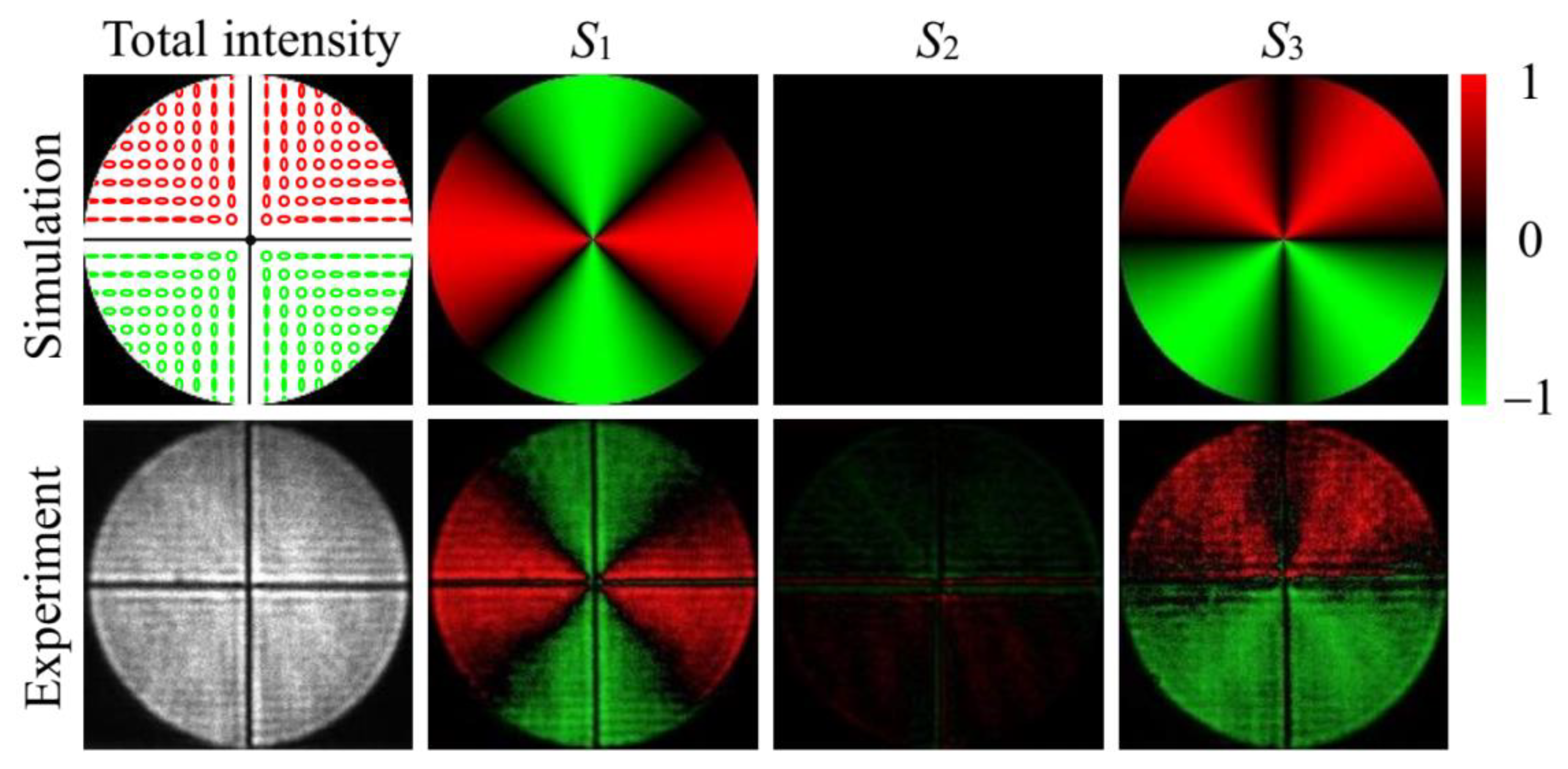
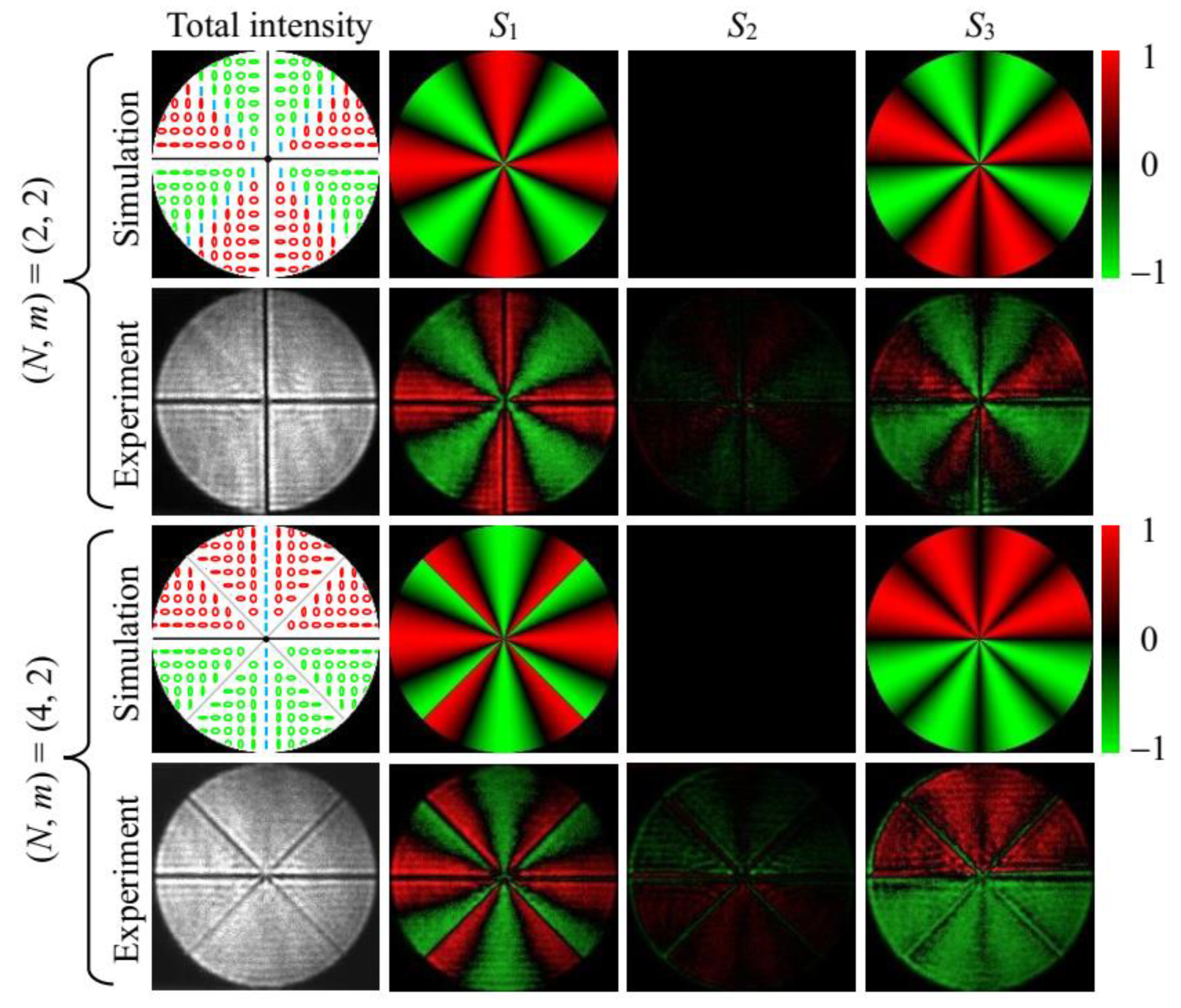
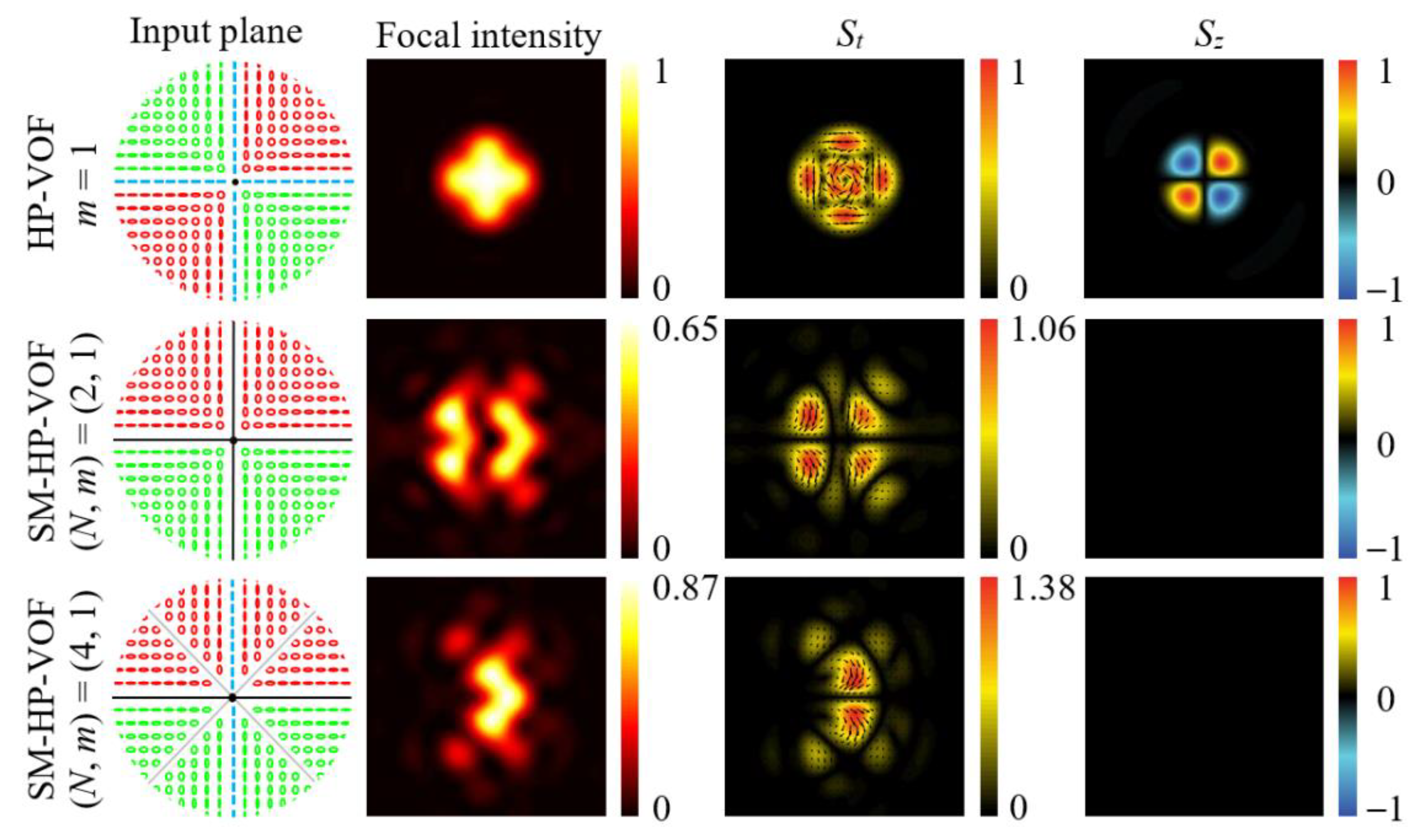
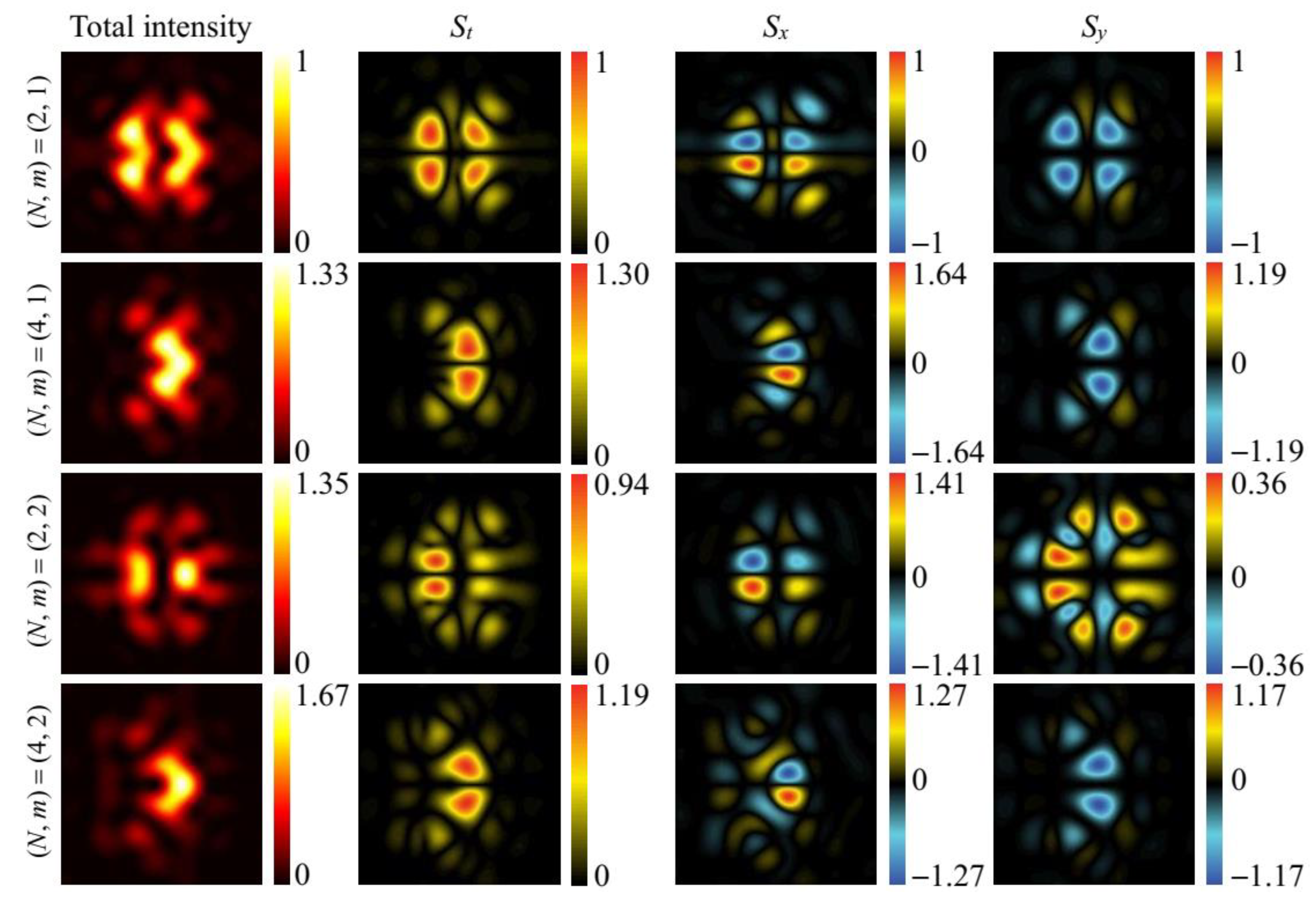
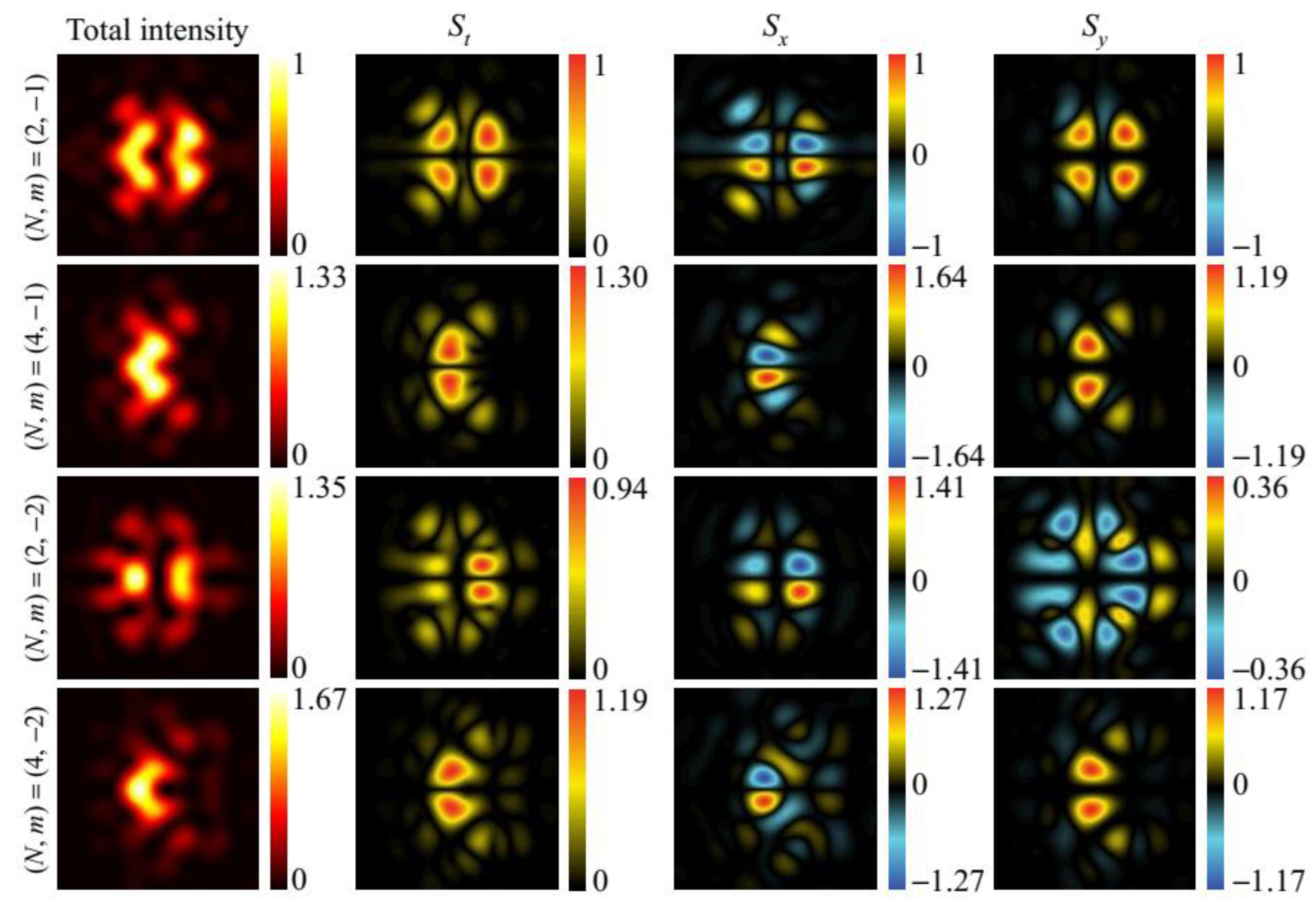
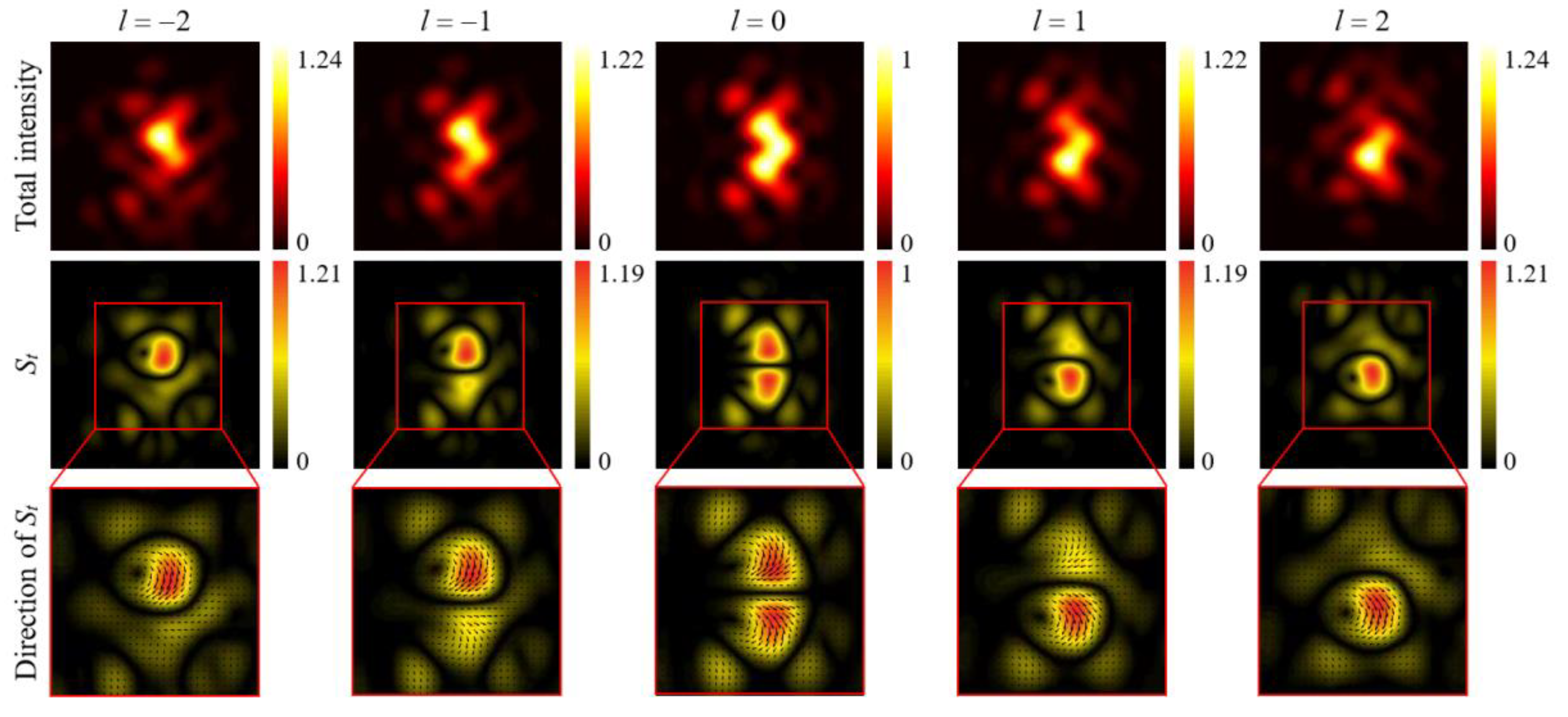
Publisher’s Note: MDPI stays neutral with regard to jurisdictional claims in published maps and institutional affiliations. |
© 2022 by the authors. Licensee MDPI, Basel, Switzerland. This article is an open access article distributed under the terms and conditions of the Creative Commons Attribution (CC BY) license (https://creativecommons.org/licenses/by/4.0/).
Share and Cite
Sun, X.-F.; Pan, Y.; Zhang, G.-B.; Man, Z.-X.; Gao, X.-Z. Manipulating Transverse Spin Angular Momentum with Symmetrically Modulated Hybridly Polarized Vector Optical Field. Photonics 2022, 9, 817. https://doi.org/10.3390/photonics9110817
Sun X-F, Pan Y, Zhang G-B, Man Z-X, Gao X-Z. Manipulating Transverse Spin Angular Momentum with Symmetrically Modulated Hybridly Polarized Vector Optical Field. Photonics. 2022; 9(11):817. https://doi.org/10.3390/photonics9110817
Chicago/Turabian StyleSun, Xue-Feng, Yue Pan, Guang-Bo Zhang, Zhong-Xiao Man, and Xu-Zhen Gao. 2022. "Manipulating Transverse Spin Angular Momentum with Symmetrically Modulated Hybridly Polarized Vector Optical Field" Photonics 9, no. 11: 817. https://doi.org/10.3390/photonics9110817
APA StyleSun, X.-F., Pan, Y., Zhang, G.-B., Man, Z.-X., & Gao, X.-Z. (2022). Manipulating Transverse Spin Angular Momentum with Symmetrically Modulated Hybridly Polarized Vector Optical Field. Photonics, 9(11), 817. https://doi.org/10.3390/photonics9110817



